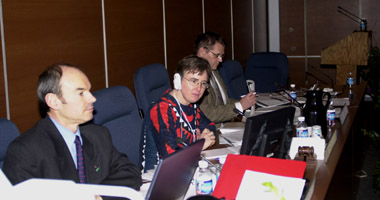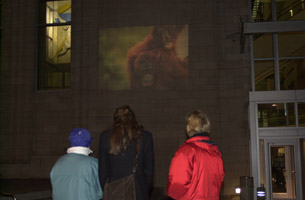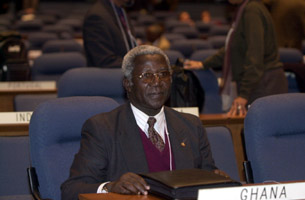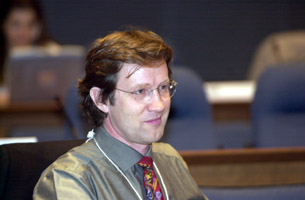|
7th
Meeting of the Subsidiary Bodies for Scientific, Technical and
Technological Advice (SBSTTA) of the Convention on Biodiversity
(CBD) |
||
|
|
||
| Highlights for Tuesday, 13 November 2001 Delegates
to the seventh meeting of the Subsidiary Body for Scientific, Technical
and Technological Advice (SBSTTA) to the Convention on Biological
Diversity (CBD) met in two working groups during the day. Working Group I
(WG-I), on forest biodiversity, heard introductory presentations and
discussed: status, trends, and threats; conservation and sustainable use;
and bushmeat. Working Group II (WG-II) discussed agricultural biodiversity
and the plant conservation strategy. Above photo: the dias during Working
Group I chaired by Paula Warren (New Zealand) |
. |
|
|
|||||||||||||||||||||||||||||||||
|
|
||
|
WORKING
GROUP I |
||
| FOREST BIOLOGICAL DIVERSITY: | ||
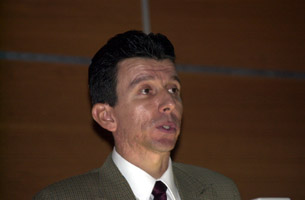 WG-I
Chair Paula Warren (New Zealand) introduced two keynote presentations. José
Joaquin Campos (left), Tropical Agriculture Research and Higher Education
Center, presented on the management of goods and services from neotropical
forest biodiversity in Costa Rica. He highlighted the need for innovative
financial mechanisms, so that forest owners might capture benefits of
sustainable forest management. WG-I
Chair Paula Warren (New Zealand) introduced two keynote presentations. José
Joaquin Campos (left), Tropical Agriculture Research and Higher Education
Center, presented on the management of goods and services from neotropical
forest biodiversity in Costa Rica. He highlighted the need for innovative
financial mechanisms, so that forest owners might capture benefits of
sustainable forest management.
|
||
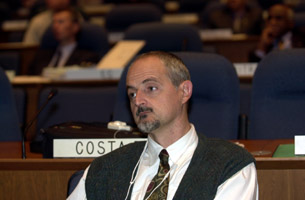 Robert Nasi (right), Center for International Forestry Research, addressed sustainable harvest of non-timber forest products (NTFPs), stressing their importance and diversity. He noted differences in perceptions of developing and developed countries regarding the use and importance of NTFPs. |
||
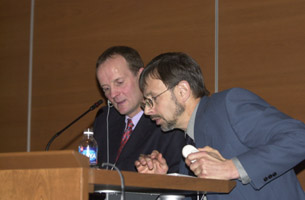 Gordon Patterson (UK) (far left) and Ian Thompson (Canada) (left), co-chairs of the Ad Hoc Technical Expert Group on Forest Biodiversity, reviewed the group's discussions, mandate, and outputs on status, trends and gaps in knowledge. |
||
| STATUS, TRENDS AND THREATS: | ||
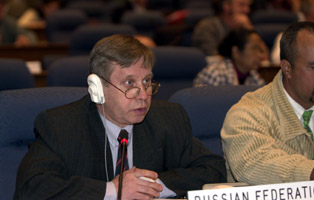 RUSSIAN FEDERATION noted international trade pressures on large forest stands. Delegates underscored cooperation with relevant international organizations. |
||
|
|
||
| CONSERVATION AND SUSTAINABLE USE: | ||
|
|
||
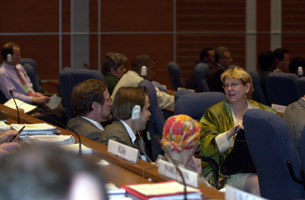 The US highlighted the CBD's role as the lead international body on biodiversity and forests, noting that the UNFF is simply a facilitative and coordinating body. Left photo: The US delegatiion during a session on WG I |
||
| BUSHMEAT: | ||
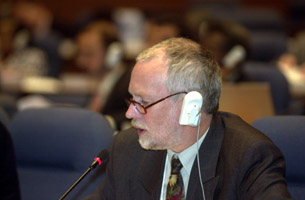 The NETHERLANDS called for differentiation of endangered species from the larger issue of unsustainable harvests. |
||
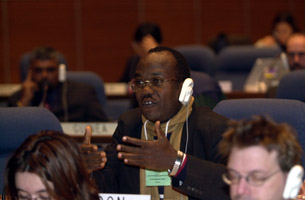 CAMEROON (left), with SENEGAL, stressed the need for alternative sources of protein. |
||
|
WORKING
GROUP II: |
||
| AGRICULTURAL BIODIVERSITY: | ||
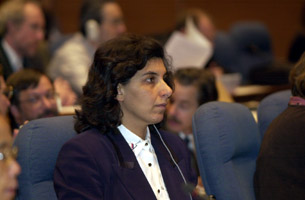 The FAO reviewed work regarding: soil biodiversity (UNEP/CBD/SBSTTA/7/ INF/11); animal genetic resources (UNEP/CBD/SBSTTA/7/INF/12 and 13); pollinators; genetic use restriction technologies (GURTs); and plant genetic resources. Left photo: Nadia El-Hage Scialabba of the FAO |
||
|
|
||
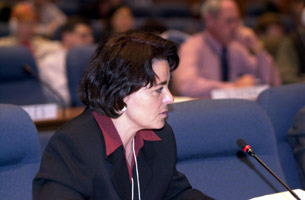 POLAND, on behalf of the FAO Intergovernmental Technical Working Group on Animal Genetic Resources, was followed by many in its call to support the first report on the state of the world's animal genetic resources. |
||
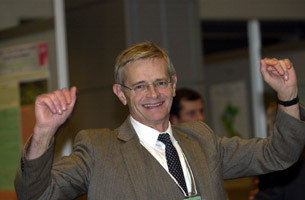 HUNGARY (left), on behalf of Central and Eastern European countries, with others, underlined capacity building and assessment of economic value of pollinators. |
||
| PLANT CONSERVATION STRATEGY: | ||
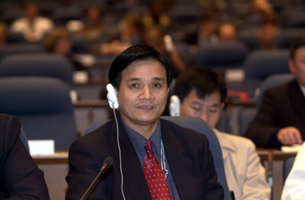 CHINA noted impacts of industrial waste on plant conservation. |
||
|
|
||
| SECTORAL INTEGRATION OF BIODIVERSITY: IMPLEMENTING ARTICLE 6b | ||
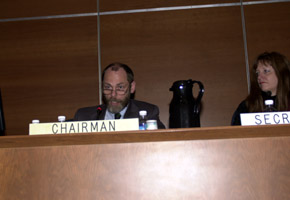 The
UNDP/GEF and UNEP presented a panel discussion on "Thematic Studies on
Sectoral Integration of Biodiversity." The event was moderated by David
Duthie (UNEP/GEF) and John Hough (UNDP) (left). The event included panel
presentations on the integration of biodiversity into various sectoral
themes. Barbara Gemmill (ELCI) presented on the national agricultural
sector, Brian Harvey (WORLD FISHERIES TRUST) on national fisheries, Robert
Nasi (CIFOR) on national forestry, Carolina Lasen (FIELD) on harmonisation
of CBD implementation with other biodiversity-related conventions and
Sheldon Cohen (The Nature Conservancy) on mobilizing funding for biodiversity
conservation. The draft results of these studies are available on
CD-ROM to participants at SBSTTA-7 or via the internet at http://www.unep.org/bpsp/TS.html The
UNDP/GEF and UNEP presented a panel discussion on "Thematic Studies on
Sectoral Integration of Biodiversity." The event was moderated by David
Duthie (UNEP/GEF) and John Hough (UNDP) (left). The event included panel
presentations on the integration of biodiversity into various sectoral
themes. Barbara Gemmill (ELCI) presented on the national agricultural
sector, Brian Harvey (WORLD FISHERIES TRUST) on national fisheries, Robert
Nasi (CIFOR) on national forestry, Carolina Lasen (FIELD) on harmonisation
of CBD implementation with other biodiversity-related conventions and
Sheldon Cohen (The Nature Conservancy) on mobilizing funding for biodiversity
conservation. The draft results of these studies are available on
CD-ROM to participants at SBSTTA-7 or via the internet at http://www.unep.org/bpsp/TS.html
|
||
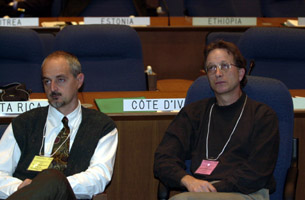
|
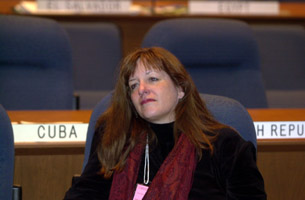
|
|
| Photos above L-R: Robert Nasi of CIFOR, Brian Harvey of WORLD FISHERIES TRUS and Barbara Gemmill of ELCI. | ||
|
|
||
| © 2001, IISD. All rights reserved. |
|


